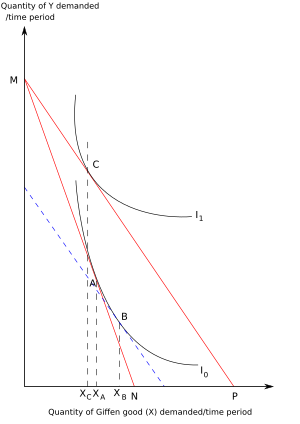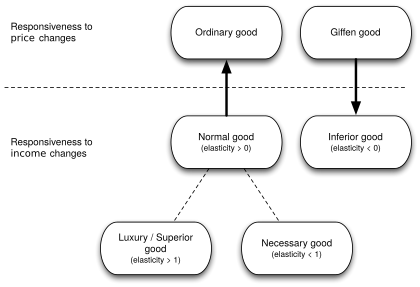Giffen good facts for kids
In economics, which is the study of how people make choices about money and resources, a Giffen good is a special kind of product. It's something that people buy more of when its price goes up, and less of when its price goes down. This is very unusual because it goes against the normal Law of Demand, which says people usually buy less of something when it gets more expensive.
This interesting idea is named after Robert Giffen, who first talked about it. He noticed that very poor families sometimes bought more bread when the price of bread increased. This happened because bread was the cheapest food they could buy. If the price of bread went up, they could no longer afford more expensive foods like meat. So, they had to spend even more of their money on bread just to have enough to eat.
A Giffen good is seen as the opposite of an ordinary good, which is what most products are.
Contents
What Is the Background of Giffen Goods?
Giffen goods are named after a Scottish economist named Sir Robert Giffen. Another famous economist, Alfred Marshall, mentioned Giffen's idea in his book Principles of Economics, which was first published in 1890. Giffen first thought of this idea after watching how poor people in the Victorian era (a time in history from 1837 to 1901) bought their food.
Examples of Giffen Goods
It's actually quite hard to find real-life examples of Giffen goods. They are very rare!
A study from 2008 by Robert Jensen and Nolan Miller suggested that rice and wheat noodles might be Giffen goods in some parts of China. This was because these foods were very important for poor families, similar to the bread example.
The Irish Potato Famine: A Famous Example?
For a long time, people thought that potatoes during the Great Famine in Ireland (from 1845 to 1849) were a good example of a Giffen good. During this terrible time, the price of potatoes and meat both went up. Potatoes were much cheaper than meat and were a main food source for many poor people.
The idea was that because people were so poor, they couldn't afford meat anymore. So, even though potato prices increased, they had to buy even more potatoes to survive. This seemed to fit the idea of a Giffen good.
However, later studies by economists like Gerald P. Dwyer, Cotton M. Lindsey, and Sherwin Rosen showed that the Irish potato probably wasn't a true Giffen good. They found that the situation could be explained by normal supply and demand rules. Charles Read, another researcher, found that bacon pigs, not potatoes, showed Giffen-like behavior during the Famine.
Other Possible Examples
- Some people have suggested that things like Bitcoin or other cryptocurrencies might sometimes act like Giffen goods.
- Anthony Bopp (in 1983) thought that kerosene, a cheap fuel used for heating homes, could be a Giffen good.
- Schmuel Baruch and Yakar Kanai (in 2001) wondered if shochu, a Japanese drink, might be a Giffen good.
- In 2005, Sasha Abramsky wrote that gasoline (petrol) could sometimes act like a Giffen good.
See also
 In Spanish: Bien de Giffen para niños
In Spanish: Bien de Giffen para niños
- Capital good
- Consumer choice
- Price elasticity of demand
- Supply and demand
- Ordinary good
- Veblen good
- Inferior good
- Normal good



